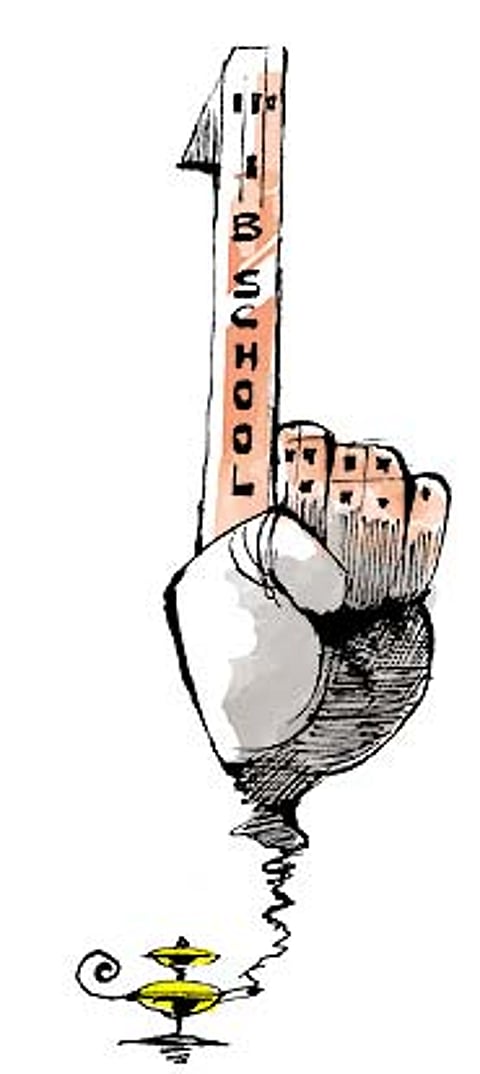Five Steps To The Top
Indian B-Schools can be world-class too provided they have the will

Though we live in an information age, this is also an age of hype on many fronts, including ‘academic hype’. Many institutions claim to be world-class, but have little or no justification to do so. More importantly, they don’t know, or even want to know, what makes a world-class institution. But it’s the ultimate goal of most schools. So far, no Indian B-school has ranked among the top 100 in the world. The only place an India B-school figures in the top 100 is among a list of ‘most difficult schools to get into’, which is expressed as a ratio of admitted to applied students.
In fact, of the three major business accreditation agencies based in the US, AACSB International accreditation represents the highest standard of achievement for business schools worldwide. AACSB International, founded in 1916, began its accreditation function with the adoption of the first standards in 1919. Interestingly, till date, no Indian business school has received AACSB accreditation, whereas institutions in China, Egypt, Philippines, Singapore, Mexico and Kuwait (to name a few outside the US) have received the coveted accreditation.
The Indian education system is highly regulated and in most cases the government pretty much regulates who you can teach, who teaches, what you should pay the teachers, what you can teach, and what you can charge students. Such stringent regulations strangle academic creativity and innovation and thwart growth. Globalisation requires institutions to have the autonomy to pursue ‘excellence’ and of course, institutions must use such autonomy responsibly and judiciously.
But what defines a world-class institution? There has yet to exist a globally accepted roster of criteria for any institution to be classified under such a category. There are many rankings of academic institutions, and most are conducted by newspapers and magazines. Only a handful of them, which have used a complex methodology involving both quantitative and qualitative factors, are taken seriously. The following are but a few of the factors that could play a critical part in the evaluation of a premier institution as possessing the highest global standards. These factors, although critical, are by no means comprehensive but are meant as benchmarks to provide the basis for debate and analysis.
Faculty development and visibility
Top-calibre professors are an unquestionable component needed to elevate the institution to the highest levels of the strata. The faculty must lead in terms of intellectual rigour, commanding relevance and artful exposition. The teachers ought to be intellectual provocateurs, whose insights are grounded on profound understanding of practice. Furthermore, a strong faculty should be able to carry out diversified research in all relevant fields of study and build visibility for themselves as well as for their institution through peer-reviewed publications, conference presentations and proceedings.
In order to attract and retain the best academic staff, favourable working conditions should exist. These include, but are not limited to, academic freedom, job security arrangements that’s widely known in most countries as tenure, and appropriate and competitive remunerations and benefits. Most professors are not seeking top salaries; the great teachers perceive their profession as a ‘calling’—something they are drawn to because of intellectual curiosity regardless of monetary compensation.
Curriculum development and academic affiliations
Institutes ought to cultivate a virtuous cycle between their faculty, the interactive pedagogical process developed in their programmes, the experience of the students and graduates, and the establishment of academic affiliations with other institutions. A contemporary curriculum that comprises diverse and well-tested pedagogy focusing on meaningful translation of concepts into practical action and a framework in which academics can engage in global benchmarking is another hallmark of excellence. Academic affiliations appear to foster collaborative learning experiences among students and within institutions. The rise in ‘consortium programmes’ has been a result of collaborative efforts among academic institutions, which has led to a more contemporary curriculum design ensuring such institutions stay ahead of the curve in management education. Most pedagogical methods appear to primarily use the cognitive way of learning. But the leading global B-schools are seriously moving toward integrating emotive, behavioural and relational aspects of learning in their pedagogies.
Student enrolment management and services

A rigorous selection process with access to a diverse and internationally competitive applicant pool, and one that admits only those students who are suited for the programme, is another important consideration. A diverse student body is a critical aspect of peer learning, particularly in professional studies. In India, the sheer number of aspiring domestic students results in B-schools not bothering to look for international students. In contrast,INSEAD, for instance, claims its student body is represented by students of over 70 nationalities, but remarkably no one nation or culture makes up more than 10 per cent of its class. In addition, over half the participants have studied or worked outside their home country prior to joiningINSEAD.
Industry interactions and alumni relations
An active relationship with the corporate world is an essential ingredient to gaining global recognition. Industry interactions ought to be designed to ensure that the institute is continuously addressing important business issues and providing its corporate constituencies with intellectual renewal that is critical for success in today’s competitive environment. Successful universities have effectively capitalised on the strength and international reach of their alumni network. Indian institutions have not yet tapped into their alumni base significantly. This happens when alumni’s sense of belongingness to their alma mater is limited and institutes need to develop strategies to build and strengthen this weak link. Some universities let their alumni keep the university’s email ID for life, thereby enhancing the sense of belonging and also ensuring easy accessibility to their alumni base.
Infrastructure facilities
Adequate infrastructure facilities for academic work and student quality-of-life on campus are essential. The most creative research and innovative teaching rely on appropriate libraries, laboratories and state-of-the-art classroom technologies. Most western schools are ahead in incorporating several learning technologies in a distributed learning mode that have proven to be effective learning tools. Funding continues to be a special challenge to academic institutions since governments worldwide are divesting from higher education. The stringent regulatory system in India, where what you can charge your student is regulated, inherently creates bottlenecks and institutions have to grapple with how to allocate their limited resources.
The debate over world-class institutions is important since it focuses attention on academic standards. But when contemplating about world-class institutions, a realistic and impartial viewpoint is called for. It should be understood that if we consider all the finest universities in the world, not a single one excels in every field of study it offers. For instance, Harvard may not be a top choice for an engineering programme but it is renowned for producing some of the finest lawyers. Of course, the spillover effects of excellence will always be there. In India, various stand-alone business institutions should consider focusing on further developing their academic functional areas of expertise to the highest standards, enabling their graduates to be at par with the best in the world.
But is becoming a world-class institution really that important in the grand scheme of things? The institution must know its own limitations. Armed with this knowledge, it would be able to focus and attain more realistic goals in line with the institution’s mission and capabilities. Formulating unrealistic goals would eventually do more harm than good, affecting the different aspects of the institute’s system such as its resources, services and faculty.
The goals, interests and nature of academic performance of an institution of higher learning will depend on whether its aim is to operate on a national scene or on a global scale. With this premise, any institution aspiring to be known globally as a world-class institute will have to contend with coming head-to-head with some of the finest schools around whereas those institutions whose outlook is mainly focused on addressing the need of the immediate populace would mostly concentrate their efforts in serving the local and regional communities. Can Indian B-schools attain world-class status? The answer is simple. Yes, they can and though it is an undertaking steeped with significant challenges, it is certainly not an impossible goal. The question is—would they want to and do they have the will to do so?
(Dr Angur, a post-graduate from IIM-A, is currently the David M. French Distinguished Professor at the University of Michigan, Flint School of Management. He haspublished over 100 papers and consulted for several Fortune 100 companies. In 2002, he was nominated for the Carnegie Foundation Professor of the Year award.)